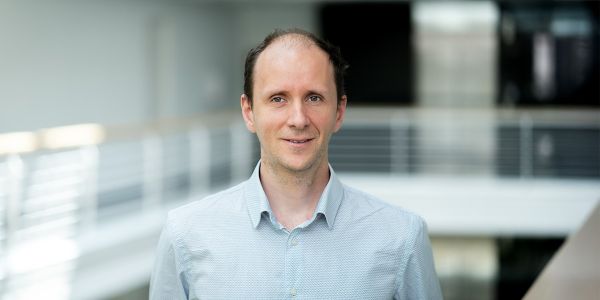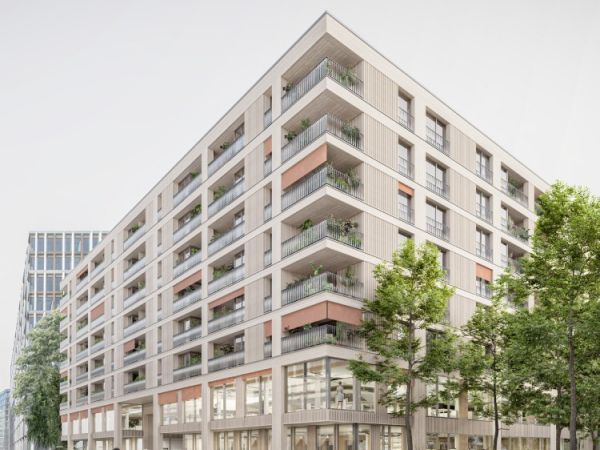
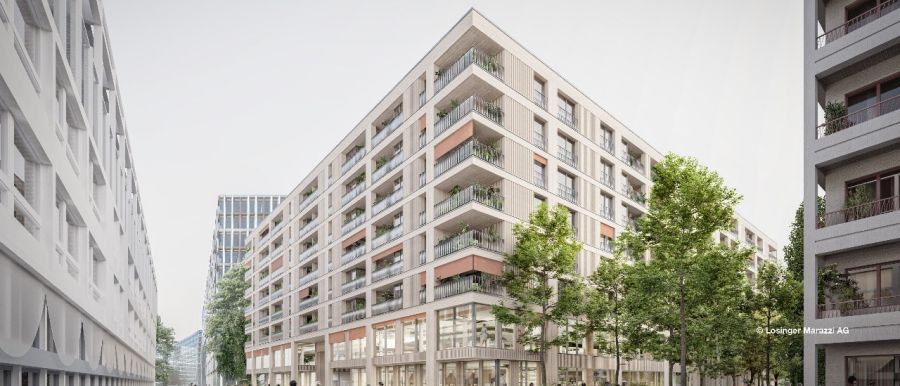
- 840 MWh/a for hot water and space heating
- 550 MWh/a for cooling
- 134 MWh/a for free cooling
- 38 kWp solar power production from PV system with investment model
Construction has been ongoing at the Greencity site in the south of Zurich since 2015. Among other things, the first 2000-watt site in Switzerland offers sustainable living space for around 2,000 people, 3,000 jobs, a school, shops and a number of restaurants. The new district is also connected with its own S-Bahn station. Developed by the real estate developer and general contractor Losinger Marazzi, the Vergé building is located between the residential and business areas and is scheduled for completion by the beginning of 2026. Losinger Marazzi is aiming for the eight-storey new building to achieve the building label SNBS Gold. It will ultimately incorporate 179 apartments adapted to the needs of the elderly, along with office and commercial space.
A new white paper provides more information about achieving net zero. It explains how companies and organisations in the real estate industry can drastically reduce their greenhouse gas emissions today in order to achieve the target of net zero by 2050 at the latest.
The aim is to minimise greenhouse gas emissions during the construction and operation of the building. There are a number of reasons why the real estate developer wants to get as close as possible to net zero. ‘In addition to our social obligation, our main focus is on climate resilience,’ explains Lennart Rogenhofer, Chief Climate Officer at Losinger Marazzi. The company wants to develop and construct buildings that are adapted to future climate conditions and legislation. ‘At the same time, it creates added value for investors, users and society,’ says Rogenhofer.
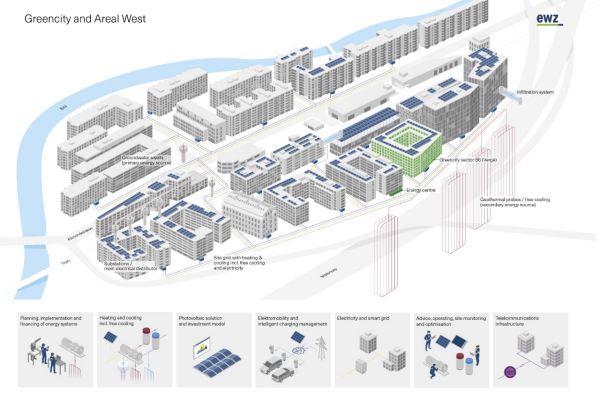
Different approaches towards achieving net zero
Losinger Marazzi examines and combines different approaches to achieve this goal. All components of the new building are checked in advance for their efficiency and for more environmentally friendly alternatives. The real estate developer is examining various measures to reduce grey energy in particular.
An important element is the materialisation of the inner walls. According to Rogenhofer, if you build non-load-bearing interior walls using lightweight construction instead of concrete, you can achieve a CO₂ reduction of around 50 per cent. Similar savings are made if a wooden façade is used instead of a concrete-rendered one. This meets the requirement for using renewable materials or those that have undergone minimal processing. Replacing the interior walls in the basement, which are usually made of concrete, with sand-lime bricks results in CO₂ savings of around 40 per cent. It is difficult to quantify the grey emissions saved by having a compact supporting structure, which minimises the amount of concrete used by optimising the ceiling thicknesses and support grid. 'That’s because no "non-optimised'" project exists for comparison,' explains Rogenhofer. The real estate developer and general contractor has also made a general decision to use low carbon concrete in its projects wherever possible.
The ventilation has also been analysed, but the implementation of a simple exhaust air system that reduces the amount of material was not possible. Well-balanced window proportions that allow for the use of daylight and optimise heat gain and loss in winter are also effective.
According to Rogenhofer, Losinger Marazzi intends to take the results of the investigations for sector B6 (Vergé) into account for future projects: “We're looking to see which measures from pilot projects like sector B6 (Vergé) can serve as standards for other buildings.” The leverage for reduction that has been exploited or examined can then be included in a catalogue of measures that forms the basis for all future projects. Losinger Marazzi will also define a CO₂ target for construction and operation of all buildings.
CO₂ reduction based on science
These measures go hand in hand with Losinger Marazzi’s climate strategy, which aims to reduce emissions as much as possible as part of the Science-Based Targets Initiative certification. By 2030, the company aims to reduce its direct CO₂ emissions by 40 per cent compared to 2021 and indirect emissions (creation and operation of projects) by 30 per cent. ‘It is particularly important to us that we follow a science-based approach to reducing greenhouse gases without offsetting – which means that net zero is currently not feasible,’ says Rogenhofer. In addition to reducing CO₂ emissions, the company also defines measurable company targets in the areas of biodiversity and the circular economy.
Innovative energy concept combines geothermal energy and groundwater
The low-carbon Vergé building will also be integrated into Greencity’s energy concept, which is based on 100 per cent renewable energies. The integrated solution for the energy infrastructure includes supplying the entire site with electricity, heating and cooling and will be planned, financed, implemented and operated by ewz. The primary energy source is groundwater, which is collected in wells and brought to the required temperature level using heat pumps. The secondary source of energy is geothermal heat, which is accessed via two large geothermal probe fields. A separate cooling network cools the offices in summer. The excess heat is stored in the ground during the summer months. In winter, the heat can be used again for the heat supply. The electricity also comes 100 per cent from renewable sources. Around 20 per cent of this is produced by the photovoltaic systems on site.
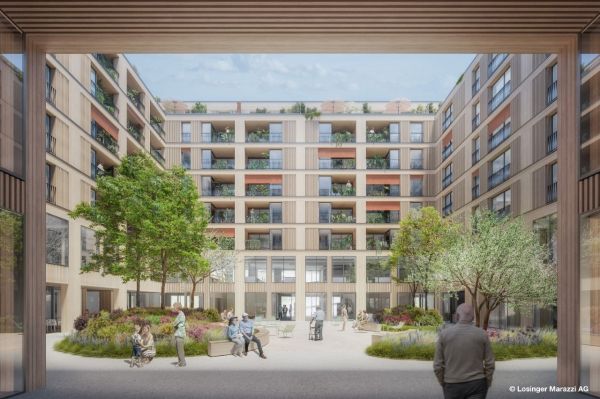
Building on empirical values
According to project manager David Füllemann, ewz has been able to gain valuable experience since the first tenants moved into the Greencity district in 2017 and this is now being integrated into the planning of the last building on the site. This has shown that the domestic hot water heat pumps can be designed with a lower output than originally planned. While energy consumption for hot water and space heating is roughly in line with forecasts, cooling requirements are much lower. It is not yet clear whether this is due to the lower office occupancy caused by the pandemic. What is clear, however, is that the regeneration of the geothermal probes is not as strong as expected. Although peak performance for heating and cooling was mostly lower than forecast, Füllemann believes that it makes sense not to restrict the size of the systems for geothermal and groundwater usage too much. Climate change and rising temperatures in particular require some scope for adaptation when it comes to cooling.
Once sector B6 (Vergé) site has been completed on the former Sihlpapier site, Losinger Marazzi and those involved in the project will be able to look back on a significant piece of pioneering work in climate-friendly construction in Switzerland.
